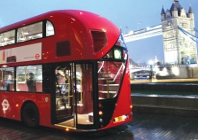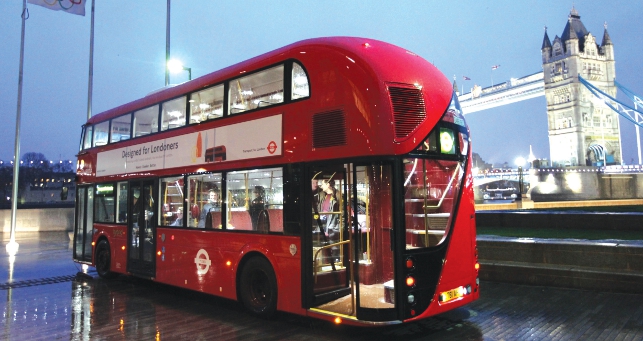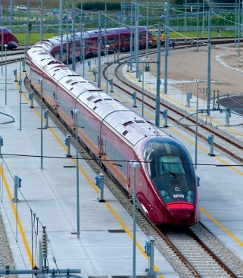Building new traditions
The mention of London’s streets summon up historic images of black cabs, the British Bobby, red telephone boxes, and the grand, red Routemaster buses.

The new bus for London designed by Thomas Heatherwick and manufactured by Wrightbus
Sadly the stately buses of old made way for standardised buses merely masquerading under a cloak of crimson paint, until last year when, thanks to the design skills of Heatherwick Studio (led by British designer du jour Thomas Heatherwick) and manufacturing know-how of Wrightbus, the New Bus for London was brought to our Capital’s streets.
An overlay of the vehicle using concept surfaces visualised in Autodesk Alias and Rhino encapsulated basic ‘shape envelopes’ but did not consider individual parts or manufacturability.
With over 66 years of bus building expertise, Wrightbus’ used Pro/Engineer Wildfire 5.0 to engineer the bus. Virtual simulations in Pro/E helped to ‘mechanise’ many of the moving parts to determine motion envelopes and functionality.
This allowed systems such as door mechanism hinging to be simulated in the virtual environment prior to physical prototype build.
Strand 7 was used for FEA optimisation, testing fatigue strength and the durability of the design, whilst minimising weight.
Full and part scale mock-ups were built from machining moulds, along with flat patterns, fabrications, forgings, castings and assemblies which were all obtained directly from the 3D CAD data.
Laser scanning was used to reverse engineer physical prototypes made by hand to produce 10 per cent accurate digital 3D model, with the same scanner re-utilised to verify manufactured part and assembly dimensions against the CAD data.
In addition to iconic looks, including the requirement for an open rear platform that would allow hop on hop off boarding, it was necessary that the bus had to have an extremely high environmental performance.
Demanding targets were set for CO2, HC and NOX making this modern urban transport one of the greenest buses on the streets. Using its own hybrid bus driveline model developed in Matlab, Wrightbus could simulate the performance of the New Bus for London driveline.
This level of sophisticated technology, means that despite its recognisable façade, the New Bus for London is an utterly modern piece of engineering.
wrightbus.com
Euro Star
Travelling across Europe by train is fast becoming one of the quickest, most comfortable and direct ways to flit between cities.
Train building giant Alstom has provided high-speed passenger trains across the continent, with the latest success coming in Italy, on the first privately operated highspeed train in Europe – the Italo.
A traveller journeying from Rome to Naples can cover the 140 miles in little over one hour.
Powered by electricity, it is driven along the rails by distributed traction, where the locomotive action is distributed throughout the entire train, instead of being pushed or pulled in the traditional manner.
This means that the layout of the train can be optimised for passengers, including a cinema and even a conference room for business meetings.
The trains themselves were built in Italy, however Alstom Transport is present in over 60 countries.
All the engineering data was supplied using Dassault Systèmes’ Enovia PLM system to implement a ‘design once, manufacture anywhere concept’ across Alstom’s many collaborating sites.
Alstom’s design and engineering team utilised Catia for the mechanical design of the train and its carriages, while the PLM system was used to manage the engineering and manufacturing bill of materials.
Street legal
Trams and streetcars have been around since 1807, when they were dreamt up by some jolly Welsh engineers.
Today they form the backbone of many public transport services around the world, including the distinctive bright yellow system found in Stuttgart, Germany.

Stuttgart’s bright yellow tram designed by Stadler Rail Group
With demanding topography from the perspective of a rail vehicle manufacturer; Stuttgart has steep gradients – up to 8.6 per cent – and a historic old town mean the trams have to meet exacting technical requirements.
Swiss-based Stadler Rail Group produces about 700 light and commuter rail vehicles per year, and has based the latest Stuttgart tram on its Tango vehicle series.
The design gives the cabs a high-floored, generous-sized interior with 106 seats and room for 146 standing passengers, as well as air-conditioning, and a top speed of 80kph.
Energy-saving LED interior lighting and the transparent driver’s cab back walls all add to the friendly design of the interior.
The tram was designed using Catia, with Stadler’s engineers validating the cabs’ crash module design through a combination of dynamic physical testing and simulations in Abaqus finite element analysis (FEA) software from Simulia.
Using SmarTeam Multi-site, Stadler can also create virtual product assemblies to help manage manufacture, speeding up the process and increasing the availability and accessibility of product data.

London’s buses, Italy’s trains, Germany’s trams: The latest in urban transport design
Default







